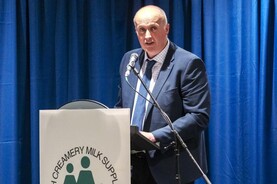IFA grain chair Kieran McEvoy has welcomed the grain prices announced last week by Tirlán and Dairygold and said grain merchants should match the prices set by the two co-ops.
“The base prices for feed wheat and barley are a fair reflection of where grain markets are currently trading. International markets softened during the summer, but they recovered throughout September. It’s good to see these recent developments have been factored into the final prices paid,” he said.
While grain prices are around 30% higher than last year, costs have increased by a similar amount. The Teagasc Outlook report estimates that average tillage farm incomes are likely to be 10% lower than last year.
“The substantial increase in grain prices is good to see, but every bit is needed to try to keep pace with escalating production costs,” he said.
Ahead of the autumn planting season kicking off in earnest, McEvoy said tillage farmers are facing an unprecedented level of uncertainty for harvest 2023.
Fertiliser prices look set to remain at historic highs, with real concerns over supply. Indicative grain future prices for 2023 would return lower prices than those announced this week.
“It’s critical that the grain industry and tillage farmers work closely together in 2023. I would call on all buyers of grain to support tillage farmers where possible and ensure the supply of native grain does not drop back next year,” the chair concluded.
Concrete levy exemption
for farmers justified
IFA president Tim Cullinan said farmers should be exempt from the concrete levy.
“Agflation is running at multiple times general inflation, so there’s huge frustration among farmers at the imposition of the 10% concrete levy as part of Budget 2023. This will further inflate the cost of doing business for farmers, who are already dealing with a massive escalation in farm input costs,” he said.
Many farmers are required to install additional slurry and soiled water storage as part of the revised Nitrates Action Programme. Farmers are also choosing to invest in their farm infrastructure to reduce on-farm labour requirements and better utilise slurry due to the escalating cost of fertiliser.
Cullinan said the concrete levy is a strong disincentive for farmers to invest in improving their farming facilities. A very large proportion of farm buildings consist of concrete, meaning that farmers are going to be disproportionately affected by this levy.
“We believe it’s entirely justified that concrete used for farm construction, either in the form of precast or readymix, should be exempted from the levy. This will form a key part of our focus in advance of the finance bill in October,” he said.
IFA grain chair Kieran McEvoy has welcomed the grain prices announced last week by Tirlán and Dairygold and said grain merchants should match the prices set by the two co-ops.
“The base prices for feed wheat and barley are a fair reflection of where grain markets are currently trading. International markets softened during the summer, but they recovered throughout September. It’s good to see these recent developments have been factored into the final prices paid,” he said.
While grain prices are around 30% higher than last year, costs have increased by a similar amount. The Teagasc Outlook report estimates that average tillage farm incomes are likely to be 10% lower than last year.
“The substantial increase in grain prices is good to see, but every bit is needed to try to keep pace with escalating production costs,” he said.
Ahead of the autumn planting season kicking off in earnest, McEvoy said tillage farmers are facing an unprecedented level of uncertainty for harvest 2023.
Fertiliser prices look set to remain at historic highs, with real concerns over supply. Indicative grain future prices for 2023 would return lower prices than those announced this week.
“It’s critical that the grain industry and tillage farmers work closely together in 2023. I would call on all buyers of grain to support tillage farmers where possible and ensure the supply of native grain does not drop back next year,” the chair concluded.
Concrete levy exemption
for farmers justified
IFA president Tim Cullinan said farmers should be exempt from the concrete levy.
“Agflation is running at multiple times general inflation, so there’s huge frustration among farmers at the imposition of the 10% concrete levy as part of Budget 2023. This will further inflate the cost of doing business for farmers, who are already dealing with a massive escalation in farm input costs,” he said.
Many farmers are required to install additional slurry and soiled water storage as part of the revised Nitrates Action Programme. Farmers are also choosing to invest in their farm infrastructure to reduce on-farm labour requirements and better utilise slurry due to the escalating cost of fertiliser.
Cullinan said the concrete levy is a strong disincentive for farmers to invest in improving their farming facilities. A very large proportion of farm buildings consist of concrete, meaning that farmers are going to be disproportionately affected by this levy.
“We believe it’s entirely justified that concrete used for farm construction, either in the form of precast or readymix, should be exempted from the levy. This will form a key part of our focus in advance of the finance bill in October,” he said.






 This is a subscriber-only article
This is a subscriber-only article











SHARING OPTIONS: